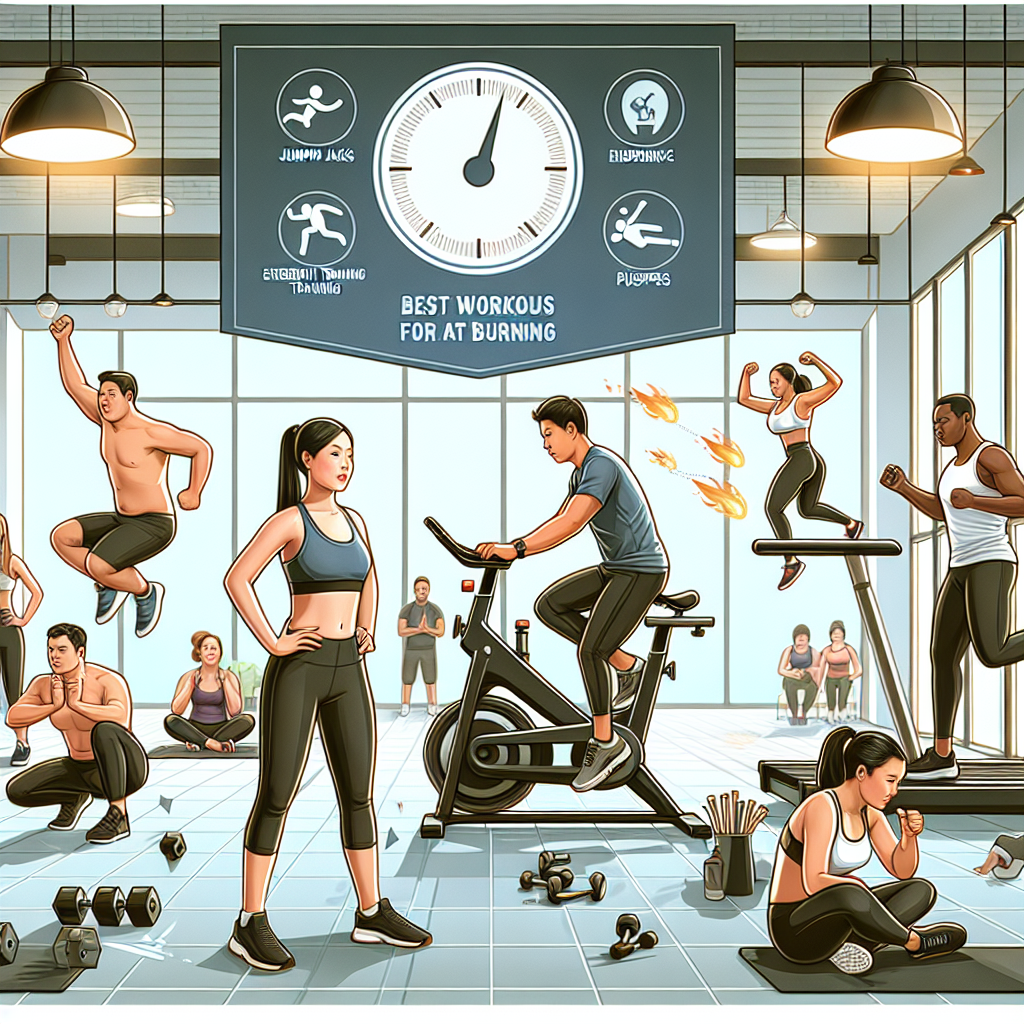Fat loss is simple in theory—burn more energy than you take in—but the smartest way to do it in practice is to pick workouts that you can stick with, protect your joints and muscle mass, and keep your metabolism humming. The best fat-burning workouts combine intensity with sustainability, build or maintain lean muscle, and create an afterburn effect (excess post-exercise oxygen consumption, or EPOC) so you keep expending energy after you’re done. Below are 10 tried-and-true workouts that check those boxes, with clear instructions, progressions, and tips so you can tailor them to your fitness level and schedule.
1) High-Intensity Interval Training (HIIT) Bodyweight Circuit
Why it works: Short, hard intervals raise your heart rate quickly, recruit large muscle groups, and create a strong afterburn with minimal equipment. It’s efficient, joint-friendly if you choose low-impact moves, and easy to scale.
How to do it:
– Warm-up: 5–8 minutes of dynamic mobility and light cardio.
– Circuit (30 seconds work, 30 seconds rest; 3–4 rounds): squat to chair, push-ups or incline push-ups, alternating reverse lunges, mountain climbers, plank shoulder taps, fast step-ups or skaters.
– Cool down: 3–5 minutes of easy cardio plus stretching.
Beginner: 20 seconds work, 40 seconds rest, 2–3 rounds.
Advanced: 40 seconds work, 20 seconds rest; add explosive moves (jump squats, burpees) if joints tolerate.
Frequency: 2–3 times per week.
Common mistakes: Going too hard too soon, letting form slip, skipping warm-up.
2) Full-Body Resistance Training (Strength First)
Why it works: Muscle is metabolically active. Strength training preserves or builds lean mass while you’re in a calorie deficit, and compound lifts drive big energy expenditure and hormonal benefits.
How to do it:
– Structure: 3 nonconsecutive days per week, full-body each day.
– Main lifts (3–5 sets of 5–10 reps): squats or leg press; hip hinge (deadlift, Romanian deadlift, or kettlebell deadlift); push (bench press, push-up, or machine press); pull (row or lat pulldown); core (carries, planks).
– Finisher (optional): 8–12 minutes of moderate intervals (sled pushes, battle ropes, bike).
Beginner: Machines and dumbbells; focus on form, 2–3 sets.
Intermediate/advanced: Progressive overload (add small weight or reps weekly), supersets to save time.
Frequency: 2–4 days per week.
Common mistakes: Only doing isolation exercises, rushing rest between heavy sets, under-eating protein.
3) Zone 2 Steady-State Cardio (The Aerobic Engine)
Why it works: Training in Zone 2 (roughly 60–70% of max heart rate; you can speak in sentences but not sing) builds your aerobic base, improves fat oxidation, and enhances recovery. It’s sustainable and low stress.
How to do it:
– Choose a low-impact modality: brisk walking, cycling, elliptical, swimming.
– Duration: 30–60 minutes per session (work up to 90 minutes once weekly if time allows).
– Intensity check: Nose-breathing or talk test; heart rate 180 minus your age (rough Maffetone method) as a guide.
Beginner: Start at 20–30 minutes, add 5 minutes weekly.
Advanced: Occasional long effort (75–90 minutes) for big caloric burn and endurance.
Frequency: 2–4 sessions per week.
Common mistakes: Going too hard (creeping into Zone 3), choosing modalities that irritate joints, boredom—fix by using podcasts or routes.
4) Sprint Intervals on a Bike or Rower (Low-Impact Power)
Why it works: True sprints recruit fast-twitch fibers, skyrocket heart rate, and produce major afterburn with lower orthopedic risk than road sprints.
How to do it:
– Warm-up: 10 minutes easy with 3 short pickups.
– Protocol A (beginner): 10 rounds of 15 seconds hard, 45 seconds easy.
– Protocol B (classic): 8–10 rounds of 20 seconds all-out, 1:40 easy.
– Protocol C (advanced): 6–8 rounds of 30 seconds hard, 2:30 easy.
Keep resistance moderate to maintain cadence; focus on all-out efforts, not medium-hard.
Frequency: 1–2 times per week, separated by at least 48 hours.
Common mistakes: Too many sprints, inadequate recovery, treating “easy” as moderate.
5) Kettlebell Swings and Complexes

Why it works: The hip hinge is a powerhouse movement. Swings train posterior chain explosiveness, elevate heart rate quickly, and tax grip and core. Complexes string moves together to minimize rest and maximize burn.
How to do it:
– Swings EMOM (Every Minute On the Minute): 10–15 swings at the top of each minute for 10 minutes. Rest remaining time.
– Complex (repeat 4–6 times with 60–90 seconds rest): 5 cleans per side, 5 presses per side, 5 front squats, 10 swings.
Beginner: Start with a light bell; practice deadlift and hike-pass; consider Russian swings only (to chest height).
Advanced: One-arm swings, snatches, heavier bells.
Frequency: 2–3 times per week.
Common mistakes: Overextending the back, squatting the swing instead of hinging, going too heavy too soon.
6) Jump Rope Intervals
Why it works: Jumping rope is a high-calorie burner per minute, improves coordination and elasticity, and is easy to do anywhere.
How to do it:
– Warm-up: 3–5 minutes of easy bouncing and ankle mobility.
– Main set (beginner): 10 rounds of 45 seconds jump, 15 seconds rest.
– Main set (intermediate): 8 rounds of 1 minute on, 30 seconds off.
– Main set (advanced): 5 rounds of 2 minutes on, 1 minute off, mixing single-unders, boxer step, and double-unders if skilled.
Scale by reducing impact: alternate low step-touch with rope or use a shadow rope. Use a mat and proper shoes.
Frequency: 2–3 times per week, total 15–25 minutes per session including rests.
Common mistakes: Excessive forearm action instead of wrist flick, landing heavy, too much too soon for calves/Achilles.
7) Incline Treadmill Walking or Rucking
Why it works: Walking is accessible and low risk. Add incline or load and you drastically increase energy cost without pounding. Great for those managing joint issues or higher body weight.
How to do it:
– Incline walk: 20–40 minutes at 8–15% incline, 2.8–3.5 mph. Maintain a brisk effort where conversation is broken.
– Progressions: Increase incline first, speed second, duration third. Avoid holding the treadmill rails.
– Rucking: Walk outdoors with a weighted backpack (start 10–15% of body weight). Go 30–60 minutes on varied terrain.
Beginner: Start at 5–8% incline or with 5–10 pounds in the pack; add small increments weekly.
Advanced: Intervals of incline (5 minutes at 12–15%, 2 minutes at 5–8%) or hills outdoors.
Frequency: 3–5 times per week.
Common mistakes: Too much load or incline early, poor footwear, leaning on treadmill handles.
8) Rowing Machine Pyramid Intervals
Why it works: Rowing uses legs, hips, back, and arms—huge energy demand. Intervals spike heart rate and tax the posterior chain while staying low impact.
How to do it:
– Technique first: Drive with legs, then open hips, then pull; reverse to return. Keep strokes per minute around 24–30 for power, not flailing.
– Pyramid workout: 250m, 500m, 750m, 1000m, 750m, 500m, 250m. Rest 1–2 minutes between pieces. Aim for consistent 500m split pace across.
– Alternative: 10 x 1 minute hard, 1 minute easy.
Beginner: Shorten rest to full recovery if needed and reduce the top distance to 750m.
Advanced: Cap rest at 1 minute or target negative splits.
Frequency: 1–3 times per week.
Common mistakes: Overusing arms, rounding the back, setting damper too high (a drag factor around 110–130 is plenty for most).
9) Boxing or Kickboxing Rounds (Heavy Bag or Pads)
Why it works: Combines high-intensity bursts with footwork and core engagement. Rotational power and constant movement yield large calorie burn, and it’s mentally engaging.
How to do it:
– Rounds: 8–10 rounds of 2–3 minutes on, 60 seconds rest. Mix straight punches (1–2), hooks, uppercuts, slips, and rolls. Keep feet moving, hands up.

– Intervals inside rounds: 10 seconds all-out flurries every 30–45 seconds, then settle to moderate pace.
– Finisher: 3 x 30 seconds of non-stop straight punches with 30 seconds rest.
Beginner: Shadowboxing to learn mechanics; light bag work; wraps and gloves to protect wrists.
Advanced: Add kicks, knees, and defensive slips; combine with jump rope warm-up.
Frequency: 2–3 times per week.
Common mistakes: Arm-punching without hip rotation, poor wrist alignment, skipping technique practice.
10) EMOM or AMRAP MetCon (Time-Efficient Burners)
Why it works: Structured density training lets you accumulate a lot of quality work in a short time, keeping heart rate elevated while using multiple muscle groups. It blends strength and conditioning for a big calorie punch.
How to do it:
– EMOM 20: Minute 1, 12 goblet squats; minute 2, 10 push-ups; minute 3, 12 kettlebell swings; minute 4, 10 bent-over rows. Repeat for 5 cycles. Pick reps you can finish in 30–40 seconds.
– AMRAP 12: 8 dumbbell thrusters, 10 box or step-ups, 12 sit-ups. Pace to move continuously.
– Choose weights that allow steady movement and perfect form.
Beginner: Fewer reps, lighter weights, longer EMOM intervals (every 90 seconds).
Advanced: Add movements like burpees, double-unders, or sandbag cleans; extend duration to 20–25 minutes sparingly.
Frequency: 1–2 times per week.
Common mistakes: Making every session a grinder, sacrificing technique for speed, poor movement selection leading to overuse.
How to choose and combine these workouts
– Weekly template (example):
• 2 days full-body strength
• 1–2 days HIIT or EMOM/MetCon
• 2–3 days Zone 2 or incline walking/rucking
• Optional: 1 session of sprints or rowing intervals
Keep at least one complete rest day.
– Progression: Increase only one variable at a time—duration, intensity, or frequency. A simple rule is the 10% guideline: don’t increase weekly training load more than about 10%.
– Recovery: Sleep 7–9 hours, walk daily, and take easy days seriously. Underslept, stressed bodies cling to weight; well-recovered bodies adapt.
– Nutrition synergy: Prioritize protein (0.7–1.0 g per pound of goal body weight), fiber-rich carbs, and healthy fats. Create a modest calorie deficit (300–500 kcal/day). Time carbs around training for performance; hydrate well and consider electrolytes for longer sessions.
– Tracking: Use a mix of measures—how clothes fit, waist circumference, performance, and average body weight over weeks. Avoid obsessing over day-to-day scale noise.
Form and safety notes
– Technique first: Good form reduces injury risk and improves output, meaning better fat loss over time. Record your lifts or ask for coaching if possible.
– Pain is a stop sign: Distinguish discomfort from sharp or joint pain. Modify movements or swap modalities when needed.
– Medical check: If you have cardiovascular, metabolic, or orthopedic conditions, consult a healthcare professional before beginning high-intensity work.
Putting it all together: sample week
– Monday: Full-body strength + 8-minute bike finisher
– Tuesday: Zone 2 cycle 45 minutes
– Wednesday: HIIT bodyweight circuit 25 minutes
– Thursday: Rest or 30-minute incline walk
– Friday: Full-body strength + kettlebell swings EMOM 10
– Saturday: Rowing pyramid or boxing rounds
– Sunday: Easy walk or complete rest
Conclusion
The best fat-burning workouts aren’t fads; they’re sustainable, scalable methods that combine muscular work with smart conditioning. HIIT and sprints deliver time-efficient intensity; strength training preserves your metabolic engine; Zone 2 and incline walking rack up reliable, low-stress calorie burn; tools like kettlebells, rowing, jump rope, and boxing keep training engaging so you actually stick to it. Choose two or three staples you enjoy, progress them gradually, and weave them into a weekly plan that you can maintain for months, not days. Pair the work with quality sleep and a sensible nutrition strategy, and fat loss becomes not just possible but predictable.

